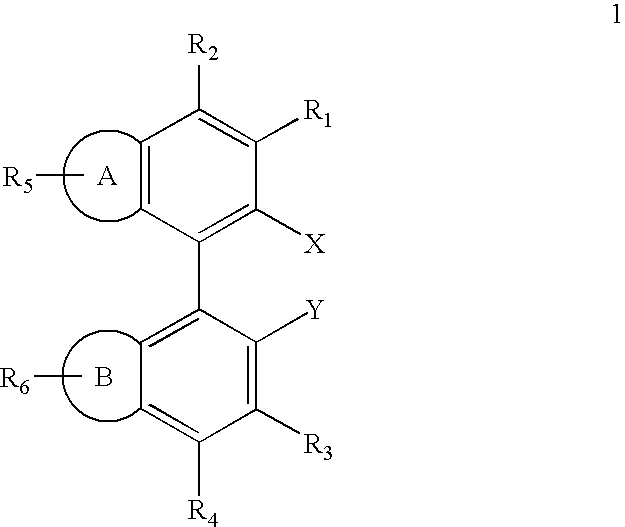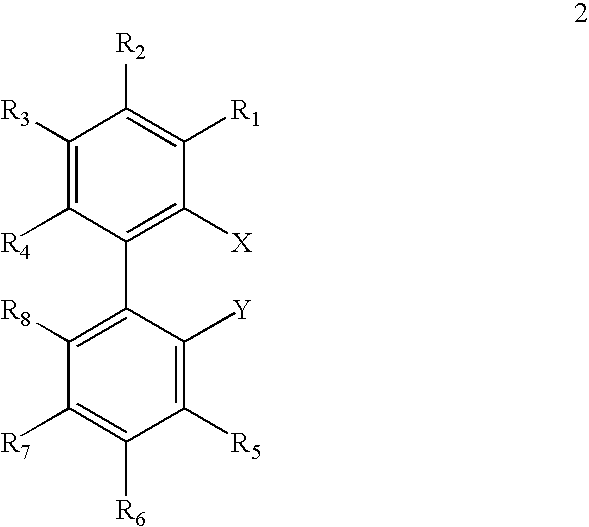Ligands for metals and improved metal-catalyzed processes based thereon
a technology of metal catalysts and ligands, which is applied in the direction of hydrocarbon preparation catalysts, group 5/15 element organic compounds, hydrocarbons, etc., can solve the problems of reducing the rate of oxidative addition in the accepted mechanism of coupling reactions, increasing the temperature of reaction, and increasing the cost of production
- Summary
- Abstract
- Description
- Claims
- Application Information
AI Technical Summary
Benefits of technology
Problems solved by technology
Method used
Image
Examples
example 1
Supporting Information for Example 1
[0432]General. All reactions were carried out under an argon atmosphere in oven-dried glassware. Elemental analyses were performed by E & R Microanalytical Laboratory Inc., Parsippany, N.J. Toluene was distilled under nitrogen from molten sodium. THF was distilled under argon from sodium benzophenone ketyl. Unless stated otherwise, commercially obtained materials were used without purification. Aryl halides were purchased from Aldrich Chemical company except for 4-chloroacetophenone which was purchased from Fluka Chemical company. N,N-dimethyl-2-bromoaniline1 was prepared by alkylation of 2-bromoaniline with iodomethane in DMF in the presence of sodium carbonate. Tribasic potassium phosphate was purchased from Fluka Chemical company. Cesium fluoride was purchased from Strem Chemical company and was ground with a mortar and pestle before use. Cesium carbonate was obtained from Chemetal and was ground with a mortar and pestle before use. Phenylboron...
example 2
Synthesis of N-(2,5-Dimethylphenyl)-N-methylaniline
[0502]
[0503]An oven-dried test tube was purged with argon and charged with Pd2(dba)3 (4.6 mg, 0.005 mmol, 1.0 mol % Pd), 2 [Example 1] (6.0 mg, 0.015 mmol, 1.5 mol %), and NaOt-Bu (135 mg, 1.40 mmol). The test tube was fitted with a septum, then toluene (2.0 mL), N-methylaniline (135 μL, 1.25 mmol), and 2-chloro-p-xylene (135 μL, 1.01 mmol) were added. The mixture was stirred at 80° C. for 13 h, then cooled to room temperature, diluted with ether (20 mL), filtered and concentrated. The crude material was purified by flash chromatography on silica gel to afford 202 mg (95%) of a colorless oil.
example 3
Synthesis of Di-n-butyl-p-toluidine
[0504]
[0505]An oven-dried resealable Schlenk tube was purged with argon and charged with Pd2(dba)3 (2.3 mg, 0.0025 mmol, 0.05 mol % Pd), 2 [Example 1] (2.9 mg, 0.0075 mmol, 0.075 mol %), and NaOt-Bu (1.34 g, 13.9 mmol). Toluene (10 mL), di-n-butylamine (2.00 mL, 11.9 mmol), and 4-chlorotoluene (1.18 mL, 10.0 mmol) were added and the mixture was degassed using three freeze-pump-thaw cycles. The reaction vessel was placed under argon, sealed with a teflon screw cap, and stirred in a 100° C. oil bath for 20 h after which time GC analysis showed the aryl halide had been completely consumed. The reaction mixture was cooled to room temperature, diluted with ether (100 mL) and extracted with 1 M HCl (3×100 mL). The combined aqueous acid phase was basified with 3N NaOH, then extracted with ether (3×150 mL). The ethereal extracts were dried over anhydrous sodium sulfate, filtered and concentrated to afford 2.01 g (95%) of a pale yellow oil.
PUM
| Property | Measurement | Unit |
|---|---|---|
| Fraction | aaaaa | aaaaa |
| Fraction | aaaaa | aaaaa |
| Fraction | aaaaa | aaaaa |
Abstract
Description
Claims
Application Information
 Login to View More
Login to View More - R&D
- Intellectual Property
- Life Sciences
- Materials
- Tech Scout
- Unparalleled Data Quality
- Higher Quality Content
- 60% Fewer Hallucinations
Browse by: Latest US Patents, China's latest patents, Technical Efficacy Thesaurus, Application Domain, Technology Topic, Popular Technical Reports.
© 2025 PatSnap. All rights reserved.Legal|Privacy policy|Modern Slavery Act Transparency Statement|Sitemap|About US| Contact US: help@patsnap.com



